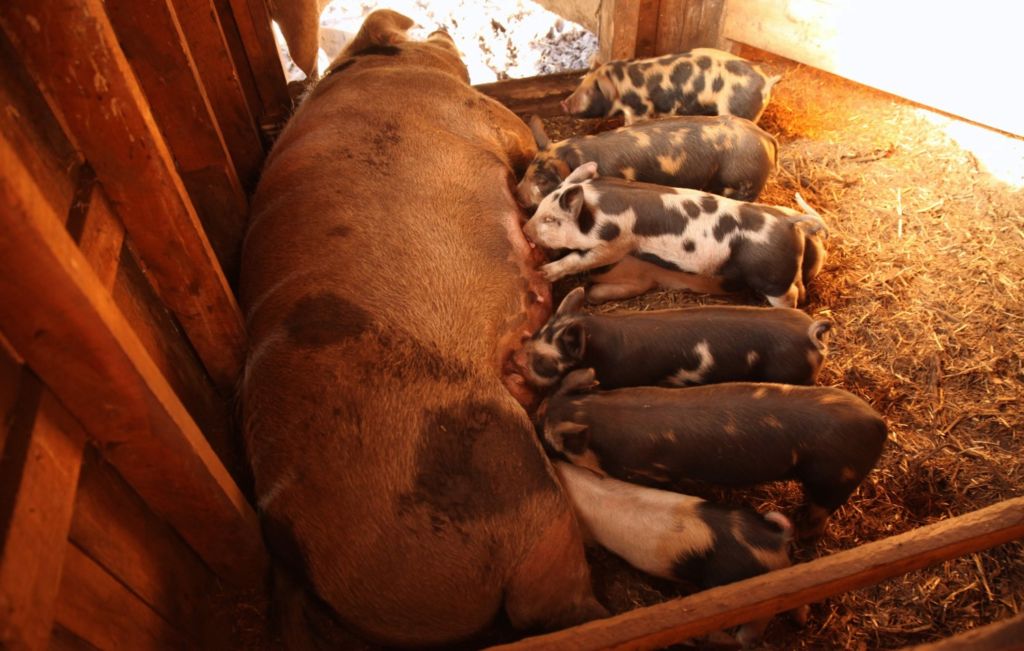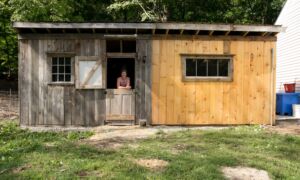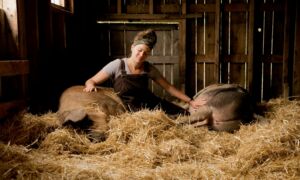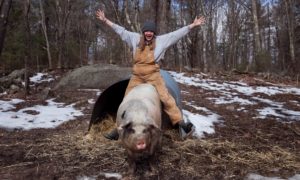Every time a new baby is born, I think I like that species most. Goats are surely my favorite when they’re kidding, and nothing can possibly beat lambs. But, if I’m being honest with myself, piglets really are the best. When I first decided to get into breeding pigs I was amazed at the seeming lack of information out there on farrowing let alone how to care for piglets. There are a billion different books on chickens, and I mean honestly, how boring are they in comparison? Yet pigs, the dogs of the barnyard and anatomically, the closest to humans, there is little information. What there is, is scattered. I don’t get it.
This is why I have made it a point to be “heavy” with the pig content on my blog. My hope is this blog can become a source of information for people who are having the same struggles that I did with the lack of information. I am certainly not an expert on the matter, but I have been around the block a few times. How to care for piglets is certainly something I should have posted about long ago, but hey, I’m only human. Better late than never!
When you farrow, you are left with a litter of piglets to contend with. I once heard that when it comes to breeding livestock, farrowing is where the men are separated from the boys. Based on some of my experiences, I don’t disagree! If you’re fortunate enough to have a good sow (who is worth her weight in gold) you can rest easier about a lot of scarier things that can happen once they’re born.
Big Marie is the most nurturing, careful, and attentive mother I could ever ask for. This is exactly why we retained two of her daughters for breeding. Despite the fact that trimmed down she’s still in the 900 pound range, she is oh so careful with every step she takes and when she lays down to try and not crush a piglet. Sadly accidents do of course happen though, and unfortunately that’s the name of the farrowing game. That’s why pigs have such large litters, to ensure some offspring survive. Oddly, it’s very un-mammal like? You will however have mothers that are “floppers” and will just go down like a sack of potatoes without taking a first look let alone a second. Or more horrible, will savage and turn on their own offspring. So, I say it again a good sow is worth her weight in gold.
While you can put a lot on mom, us humans do have a hand in things. There are some things that we need to do for the piglets after they’re born, and a general timeline to follow to ensure we are raising a healthy litter with as little loss as possible.

Immediately After Birth
How to care for piglets after they’re born is not much different than caring for goats. With any animal we raise there is a general post birthing sequence I follow: dry & warm, dip, drench, colostrum. This is a common theme outside any special cases or abnormal birthings.
Depending on the time of year you’re farrowing and if you happen to be there of course, the drying part may be unnecessary. In cold climates, it is important to get the piglets dry as quickly as possible. Rather than using rags or towels, I keep a bucket of mistral powder close by to sprinkle on piglets and rub all over them. It’s a mineral based anti-bacterial absorbent that absorbs any moisture and allows them to get warmer quicker. It literally sucks the moisture right off their bodies. Once they get a good coating of mistral, I quickly hold them against my chest and trim their umbilical cord if needed, and give good soaking spray of iodine. This is followed by a couple of pumps of nutridrench in their mouth. Give that awesome sow some nutridrench too to help give her a boost and keep the party going.
I sprinkle mistral on each piglet as they’re born. The rest of the process (dip and drench) is given to each piglet individually once we have a few on the ground, and after I’m sure they’ve gotten some colostrum. Just like with goats, sheep, or any other mammal, colostrum is essential. From this point on, it is just a matter of observing the piglets and making sure they are nursing and (hopefully) not snuggling with mama. Depending on where your sow decided to farrow, the piglets may need help finding their creep space initially. If need be, I will put each one in there after i’m sure they’ve nursed. This way they learn where it is, and that it is a warm area they will be wanting to go.
Days Following Farrowing
Piglets are born with a limited store of iron, and due to their accelerated growth they require supplemental iron for tissue growth and blood production. The stores that a piglet is born with is only enough to sustain them for 3-4 days before becoming anemic. Supplemental iron can come from natural sources such as dirt when raised outdoors. But, when raised inside or born in the winter when the ground is frozen, it must come in the form of an injection.
If your piglets have no access to a natural source, they should each get a 2ml (or what your bottle specifies) shot of injectable iron with a 1/2″ 20 gauge needle to the neck. If they have access to the outdoors, rooting through the soil or the soil on the sow’s udder when nursing should be sufficient to make up for this deficiency.
How can you tell if they have enough? You will be able to tell fairly easily if your piglets are anemic. Piglets will become lethargic, look white or jaundiced, have pale eyelids (think FAMANCHA in goats), rapid breathing, and scours. These all indicate a deficiency, and they should be dosed.
Within the first week of life, piglets are highly susceptible to scours due to an immature digestive system . While the consistency and color of the piglet’s poop will naturally change as the sows milk turns from colostrum to milk, it’s important to be on the lookout for excessive scouring. It can be caused by something as innocent and temporary as them gorging on milk, to a more serious and persistent cause such as E.Coli or Rotovirus. If it should happen and it seems excessive or concerning, it should be addressed quickly with an oral solution such as Spectoguard.
Under 2 Weeks of Age
At around a week old, I start to incorporate creep feed into the piglets diet. Essentially creep feed is just soaked grain/feed. Soaking the feed good and sloppy makes it more palatable and digestible for them at this age. They will still feverishly nurse from the sow, but at this age they do start to transition to nibbling on feed. I soak a little feed with goats milk or whey to make it more desirable for them, but regular milk or even water will work just as well. Put it in a large shallow pan in their creep space away from mama, where they can nibble on it in peace. Soaked feed does spoil quickly, so it’s best to toss what isn’t eaten after 24 hours. Start with a small amount as they won’t eat much initially so you have minimal waste. As they start to get the hang of it and eat more, you can increase the amount of feed and dial back the sloppiness.
Under the two week mark, unless you are keeping a male in tact for breeding, this is the time to castrate. Admittedly this is the worst part and the least fun job. The general rule is castrate the males as soon as you possibly can. So, if you can protrude the testes, castrate. For us, we try to do it by one week of age at max. Doing it at as young of an age as possible has numerous benefits. Not only is the piglet physically smaller and easier to hold and handle, but it will bleed less, heal faster from the antibodies in the sows milk, and poses minimal risk for a hernia when done properly. This is in addition of course to less nerve development which means less pain. Pig’s skin heals incredibly fast, especially at a young age. The castration itself is a simple process seen in a timelapse below:
- Sterilize area with iodine
- Cut slits over the protruded testes with a sharp scalpel or some people use side cutters (admittedly this Is where I need to speed things up because I always try to cut as small of a slit as possible when honestly it doesn’t matter)
- Pop the testes out, and pull to allow the spermatic cord to rip on its own as opposed to cutting. Not only is this faster, but it heals quicker. The more spermatic cord you pull the better.
- Repeat with other testis and check to make sure spermatic cord isn’t left hanging. If it is, trim it at the site of incision.
- Spray with diluted chlorhexidine solution and send him on his way
They will be immediately be back up and running around, and by the next day it will already be healing and scabbing over.
Depending on the climate, within the first two weeks you can start to raise or adjust the timing of the heat lamps and mat. When piglets are born they require incredibly warm conditions in the 80°-90°F range, as they don’t have any fat to help stay warm. It is a proven fact that initial environmental temperature conditions has a direct correlation to piglet mortality. The warmer you keep them, the greater chance of survival. Not only this, but the larger size at weaning. As they grow, piglets will require less heat. This can easily be gauged based on their behavior. If they’re piling, huddling, or shivering, clearly it isn’t warm enough and the heat lamps need to be lowered or additional ones added. If they are lying next to each other and seem content and at ease, the temperature is good. This is highly variable depending on the time of year and climate, and behavior is going to be your best indicator on if the conditions are acceptable or not.
Two Weeks On
From this point on until weaning, it’s just a matter of basic maintenance. Continuing to dial back the supplemental heat or turning it off altogether, as well as increasing the amount of creep feed. At around two to three weeks when they are getting adventurous and able to withstand the elements, this is when we begin to train them on our electric netting.
Piglets will still continue to nurse up until the time of weaning (6-8 weeks), but they will naturally get more interest and desire to eat supplemental feed as well. Once they have reached the appropriate size/age, we physically separate the sow from piglets. Feeders we are selling go to their new homes and the rest we keep to raise for meat.

It is our desire to raise our pigs as naturally as we possibly can given our climate and land. The piglets have access to the outdoors from day 1, and are raised completely outdoors from weaning until butchering. Because they are raised with space to move and roam and not be confined, things like docking tails and cutting needle teeth are unnecessary things for us to do. Our pigs need their tails to swoosh away flies in the summer, and we have never had even an inclining of a problem situation with needle teeth as newborns or adults. So if this is something you need, consider that in your timeline. Another thing to take into consideration is your vaccination protocol. Depending on what your philosophy is you may choose to vaccinate or not. This is something that should be worked out with your vet for what works best for you in your geographic location. This is not something I am educated enough on, or feel comfortable offering any kind of advice.
This general timeline works well for us, our needs, and our set up. Maybe you live in the south and rather than battling cold you have excessive heat. Or, maybe you are in the same climate and have a completely different set up and system altogether! Just like with any other livestock, make it your own and do what works for you and your animals. This is a good general timeline that works for us and the piglets we raise. For more on all things pigs in general and specifically farrowing, be sure to check out my numerous other posts as well 😀
Happy Farrowing,




Amazing post, as always! Thank you for sharing so much
Thank you for reading! 🙂
Thanks so much for this post! We are voraciously reading all of your posts on pigs as we prepare to begin raising our own. My only question in reading/watching about castration–and maybe this is my own bleeding heart here–but does this not require any anesthesia for the piglets? Thanks again for all the info!!
Awesome, hope you’re finding the information helpful! So there are definitely two schools of thought on administering anesthesia or pain medication of some sort. I am of the philosophy (after doing it and seeing the piglets during and after) that administering a local is just another “thing” that they have to go through that will prolong the process. Because there is of course stress and some level of pain associated with it. The castration is so quick that we just get it done as fast as possible (and it is fast) and we don’t want to prolong the process any longer than we have to. Once it’s done there is zero down time, he is booting around running around with his litter mates again. Everyone has their own opinion on the matter, that’s just mine!
Brilliant!
Just wanted to thank you for the integrity and great resources that you provide on your blog pertaining to raising pigs. I have learned so much from you and so appreciate you.
We have raised weiner pigs for 15 years, getting the pigs from a local farmer, but after watching you talk about A-Iing pigs I felt that with your excellent resources I was ready to go to the next level. Hence Matilda!! We purchased her bred and she just farrowed last night. Your blog was the one I went to for direction.
Julie,
Thank you so much! It has been a specific goal of mine to be a source of information specifically for pigs because the information is seriously lacking out there. So happy to hear that it was helpful and best of luck with your first litter!
Your blog is always a wealth of information!!